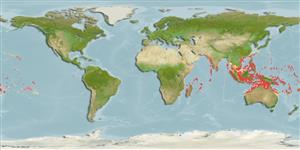>
Anguilliformes (Eels and morays) >
Muraenidae (Moray eels) > Muraeninae
Etymology: Rhinomuraena: Greek, rhinos = nose + Latin, muraena = morey eel (Ref. 45335).
More on author: Garman.
Environment: milieu / climate zone / depth range / distribution range
Écologie
marin récifal; non migrateur; profondeur 1 - 67 m (Ref. 90102). Tropical; 32°N - 26°S
Indo-Pacific: East Africa to the Tuamoto Islands, north to southern Japan, south to New Caledonia and French Polynesia; including Marianas and Marshalls.
Length at first maturity / Taille / Poids / Âge
Maturity: Lm 107.0, range 94 - 120 cm
Max length : 130 cm TL mâle / non sexé; (Ref. 2334)
Épines dorsales (Total): 0; Épines anales 0; Vertèbres: 270 - 286. Has three fleshy tentacles on the tip of its lower jaw, a single fleshy pointed projection at the tip of its snout, and tubular anterior nostrils ending in gaudy, fanlike expansions.
Adults occur in lagoon and seaward reefs. They are secretive species normally hidden in sand or rubble, sometimes with only its head protruding. Feed on small fishes (Ref. 9710, 48635, 75154, 89972). Juveniles all black, males have yellow dorsal fin and females change to a nearly all yellow color, but usually with blue in the posterior (Ref. 48635). Only moray that undergoes abrupt changes in coloration and sex: it is a protandrous hermaphrodite, i.e., functioning males reverse sex to become females. Protandry is diagnosed based on colouration, but not confirmed (Ref. 103751).
Life cycle and mating behavior
Maturité | Reproduction | Frai | Œufs | Fécondité | Larves
Protandry is diagnosed based on colouration, but not confirmed (Ref. 103751).
Chen, H.-M., K.-T. Shao and C.T. Chen, 1994. A review of the muraenid eels (Family Muraenidae) from Taiwan with descriptions of twelve new records. Zool. Stud. 33(1):44-64. (Ref. 6934)
Statut dans la liste rouge de l'IUCN (Ref. 130435)
Menace pour l'homme
Harmless
Utilisations par l'homme
Aquarium: Commercial
Plus d'informations
RéférencesAquacultureProfil d'aquacultureSouchesGénétiqueElectrophoresesHéritabilitéPathologiesTraitementNutrientsMass conversion
CollaborateursImagesStamps, Coins Misc.SonsCiguateraVitesseType de nageSurface branchialeOtolithesCerveauxVision
Outils
Articles particuliers
Télécharger en XML
Sources Internet
Estimates based on models
Preferred temperature (Ref.
123201): 24.6 - 28.8, mean 27.5 °C (based on 552 cells).
Phylogenetic diversity index (Ref.
82804): PD
50 = 1.0000 [Uniqueness, from 0.5 = low to 2.0 = high].
Bayesian length-weight: a=0.00050 (0.00025 - 0.00101), b=3.26 (3.10 - 3.42), in cm total length, based on LWR estimates for this (Sub)family-body shape (Ref.
93245).
Niveau trophique (Ref.
69278): 4.5 ±0.80 se; based on food items.
Résilience (Ref.
120179): Très faible, temps minimum de doublement de population supérieur à 14 ans (Preliminary K or Fecundity.).
Fishing Vulnerability (Ref.
59153): Very high vulnerability (78 of 100).
Nutrients (Ref.
124155): Calcium = 22.6 [12.0, 35.3] mg/100g; Iron = 0.436 [0.257, 0.889] mg/100g; Protein = 18.8 [16.6, 21.4] %; Omega3 = 0.102 [0.046, 0.293] g/100g; Selenium = 49.2 [25.9, 97.7] μg/100g; VitaminA = 86.8 [25.0, 291.3] μg/100g; Zinc = 0.721 [0.498, 1.001] mg/100g (wet weight);
